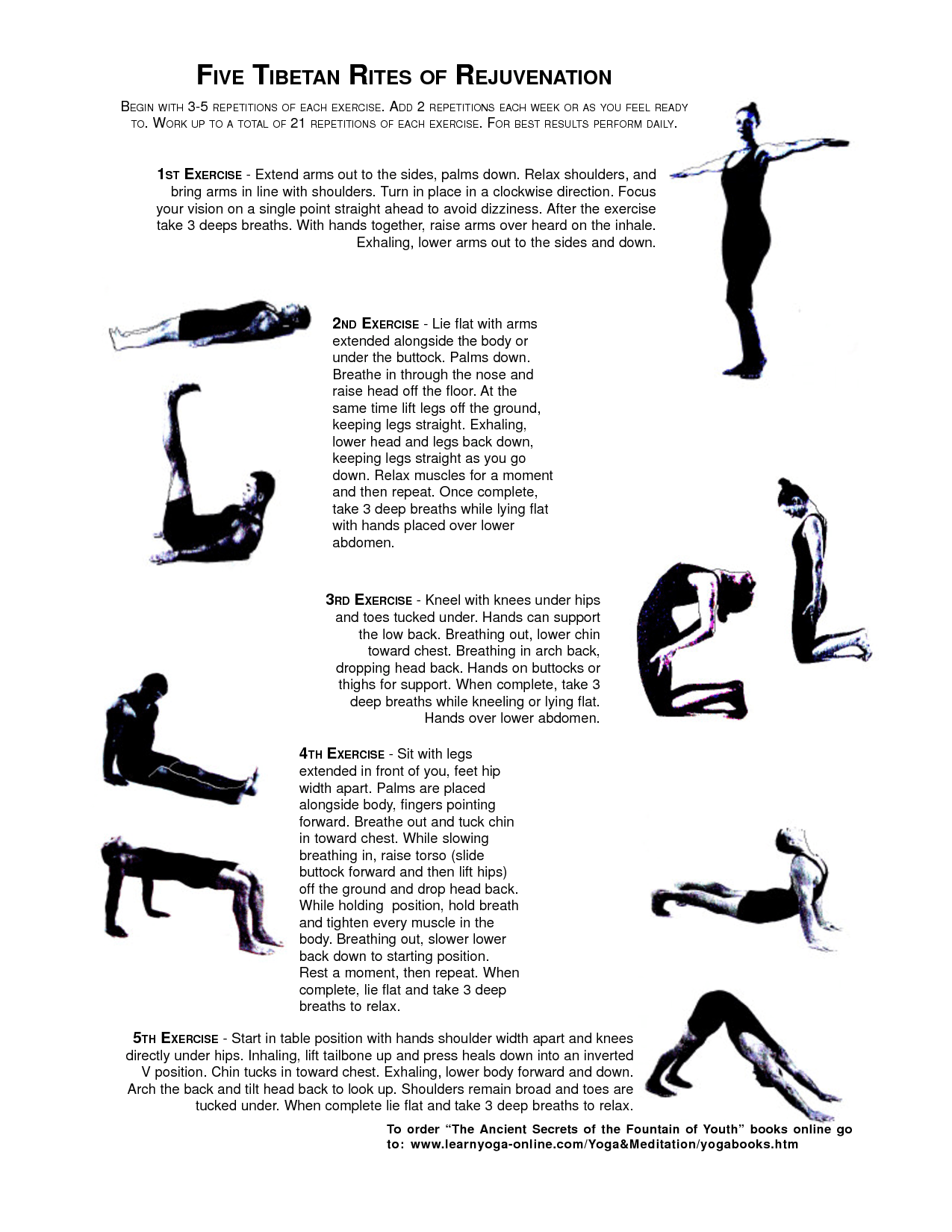The Five Tibetan Rites of Rejuvenation area a series of five yogic movement exercises which are repeated up to 21 times each as a method of keeping the spine aligned and helping maintain balance and coordination. A so called ‘fountain of youth’, these five simple exercises can be done in 10 minutes in the morning. They are also an effective chakra alignment practice, which can be important as we age.
•
Performing the Rites
In the original The Eye of Revelation booklet, Kelder suggests standing erect between each of the Five Rites with hands on hips and taking one or two deep breaths; he neither implies nor suggests that specific breathing patterns should be adopted while performing the movements. Nevertheless, subsequent publications from Five Tibetans Teachers contain edits which recommend and detail specific instructions for breathing while performing the exercises. Practitioners also recommend taking caution before performing the Rites due to the possibility of aggravating certain health conditions, or overstraining the body.
Kelder cautions that when performing the First Rite, spinning must always be performed in a clockwise direction. He also states that Bradford clearly recalled that the Maulawiyah, otherwise known as “Whirling Dervishes”, always spun from left to right, in a clockwise direction. No mention is made of the orientation of the palms, although the original illustration of the Rite in the 1939 edition of The Eye of Revelation clearly depicts both palms as facing toward the ground. Here arises a point of contention: the Whirling Dervishes spin in the counter-clockwise direction, with the left palm facing down, towards the earth, and the right palm facing up, towards heaven. However, this discrepancy may find partial resolution in the fact that Tibetan Buddhist yoga regards clockwise rotation to be favorable, whereas counter-clockwise rotation is considered to be unfavorable.
First Rite
“Stand erect with arms outstretched, horizontal with the shoulders. Now spin around until you become slightly dizzy. There is only one caution: you must turn from left to right.” If you get dizzy, slow down, or do fewer repetitions. You can also improve the smoothness of your technique, or try a few natural remedies.
Second Rite
“Lie full length on rug or bed. Place the hands flat down alongside of the hips. Fingers should be kept close together with the finger-tips of each hand turned slightly toward one another. Raise the feet until the legs are straight up. If possible, let the feet extend back a bit over the body toward the head, but do not let the knees bend. Hold this position for a moment or two and then slowly lower the feet to the floor, and for the next several moments allow all of the muscles in the entire body to relax completely. Then perform the Rite all over again.”
“While the feet and legs are being raised it is a good idea also to raise the head, then while the feet and legs are being lowered to the floor lower the head at the same time.”
Third Rite
“Kneel on a rug or mat with hands at sides, palms flat against the side of legs. Then lean forward as far as possible, bending at the waist, with head well forward—chin on chest. The second position of this Rite is to lean backward as far as possible. Cause the head to move still further backward. The toes will prevent you from falling over backward. The hands are always kept against the side of the legs. Next come to an erect (kneeling) position, relax as much as possible for a moment, and perform Rite all over again.”
Fourth Rite
“Sit erect on rug or carpet with feet stretched out in front. The legs must be perfectly straight — back of knees must be well down or close to the rug. Place the hands flat on the rug, fingers together, and the hands pointing outward slightly. Chin should be on chest — head forward.”
“Now gently raise the body, at the same time bend the knees so that the legs from the knees down are practically straight up and down. The arms, too, will also be vertical while the body from shoulders to knees will be horizontal. As the body is raised upward allow the head gently to fall backward so that the head hangs backward as far as possible when the body is fully horizontal. Hold this position for a few moments, return to first position, and RELAX for a few moments before performing the Rite again.”
“When the body is pressed up to complete horizontal position, tense every muscle in the body.”
Fifth Rite
“Place the hands on the floor about two feet apart. Then, with the legs stretched out to the rear with the feet also about two feet apart, push the body, and especially the hips, up as far as possible, rising on the toes and hands. At the same time the head should be brought so far down that the chin comes up against the chest. Next, allow the body to come slowly down to a ‘sagging’ position. Bring the head up, causing it to be drawn as far back as possible.”
“The muscles should be tensed for a moment when the body is at the highest point, and again at the lowest point.”
(Source: Wikipedia)
•
Here are more detailed instructions:

•
And here is an instructional video:
•
Go to my Tai Chi Classes page
Be First to Comment